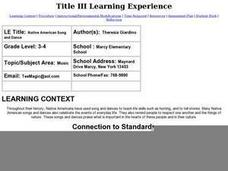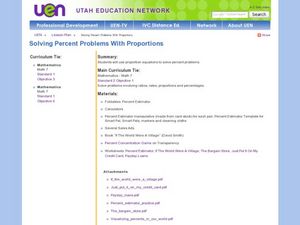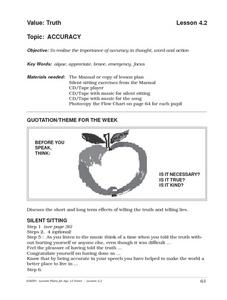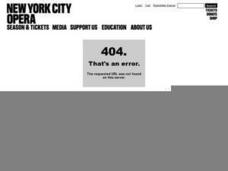Curated OER
Melodic Rhythms of India
Students listen to and dance to the music of India. After listening to the music again, they identify the different types of instruments playing the melody. They explain the tabla tarang and view photographs of people performing the music.
Curated OER
Stars and Stripes Forever: Flag Facts for Flag Day
Students are introduced to the symbolism of the flag of the United States of American. They identify flag components, history, etiquette and lore. They also use constrution paper to make a flag and discuss the Pledge of Allegiance.
Curated OER
Strange Encounters
Third graders examine a variety of Robert Harris' paintings. Using the characters in the art, they develop a conversation between them in a musical verse. In groups, they identify safety procedures to be used by those traveling in the...
Curated OER
Trey and Dave Go to Africa
Students explain the similarity of musical meanings and uses of music globally. They explain the different ways in which music is valued within societies.
Curated OER
Tune Up Your Ears!
Students discuss meaning of pitch, listen for different sounds in classroom, hallway, and outdoors, and listen to sounds played on piano and on computer to determine high or low pitch.
Curated OER
One Song, Many Voices
Students discuss the purpose and meaning of the song "One Song, Many Voices" and how the music expresses the composer's message. Students sing, conduct, and analyze two different songs during the lesson in a choir setting. This lesson is...
Curated OER
Storytellers: The Dixie Chicks
Students compare/contrast compositional devises. They describe events occurring within a musical example. Students explain the roles of creators, performers, and others involved in music productions and presentations.
Curated OER
March of the Siamese Children
Students listen to a piece of music called "March of the Siamese Students." They discuss the country and people of Thailand. Next, they sing the song, Here We Go Round the Mulberry Bush, and talk about things they do each day.
Curated OER
Native American Song and Dance
Students examine the importance of the drum and drumming in the cultural context of the Native American. Musical insturments and native dance is employed to support the focus of the lesson.
Curated OER
Bossa Nova
Students study the creators of a musical style that is a cornerstone of popular music today. They examine how that style was born, grew, and became accepted in its home and around the world.
Curated OER
Ooooh, The Oud
Students listen to a performance of the instrument, oud. After watching a video, they discover how many parts of the world it is used in and locate the countries on a map. They compare and contrast the oud with other instruments from the...
Curated OER
Solving Percent Problems with Proportions
Seventh graders explore the concept of percent problems. In this percent problem lesson, 7th graders use proportion equations to solve percent problems. Students find percentages of numbers and use proportions to determine percents in...
Curated OER
"Carnival Overture"
Students assess that music can be used to express feelings and create a story portraying many different feelings based on "Carnival Overture," by Antonin Dvorak. They become more educated listeners as they listen to and interpret...
Curated OER
Simple Gifts
Students examine the concepts of half notes, quarter notes, whole notes, and musical phrases by performing the Shaker song "Simple Gifts". Emphasis is placed on movement with music and meeting national standards for the arts.
Curated OER
Instrumental And Orchestral Development
Pupils use the computer software "Sibelius" to investigate the development of the Orchestra and specific instruments throughout human history. This lesson plan can be used in conjunction with other lessons or as a stand-alone, small...
Curated OER
Value: Truth, Topic: Accuracy
Sixth graders listen to music as they reflect on a time they told the truth without hurting anyone. Students listen to a story about a person who falls from a roof and breaks his leg. The person lies about how it happened. Students...
Curated OER
Edward Elgar
Students explore the music of Edward Elgar. As a class, they listen to Elgar's "Nimrod" and the "Adagio Cantabile" from Beethoven's piano Sonata. They listen to the music, write down the moods and discuss their feelings. Students compare...
Curated OER
The Letter Dd
Students explore the concept of the letter Dd. In this letter recognition lesson plan, students are engulfed with items, movement, and music that begin with the letter Dd. Students create crafts that help them learn and...
Curated OER
Using Shanties to Create Lyrics
Students demonstrate an understanding of shanties, a traditional music form. They listen to several shanties and create their own verses to add on to these songs. They express their feelings through music by using rhythm and rhyme to...
Curated OER
Fun with Phylogenetic Trees
Tenth graders differentiate angiosperms and gymnosperms. In this biology instructional activity, 10th graders construct a musical phylogenetic tree from information they gathered on resource websites. They present their project in class.
Curated OER
Zip-A-Dee-Doo-Dah
Students sing "Zip-A-Dee-Doo-Dah" with others in small groups and as an entire class. Using correct posture, correct rhythms, and accurate pitches, students play improvised melodies as accompaniment to the song. This lesson emphasizes...
Curated OER
THE TRAVELS OF BABAR: An Adventure in Scale : Integrating Visual Art and Social Studies
Students comprehend how the use of color impacts a work of art. They research how a theme can be rendered in a variety of ways (words, music, visuals). Students analyze how an artist's choices affect the aesthetic quality of artwork.
Curated OER
Fame, Fortune and Responsibility
Students become aware of the problem with HIV/AIDS in Madagascar and Kenya. This lesson brings a social awareness of a variety of issues to students through the study of celebrities and their causes.
Curated OER
How Are Boundaries Made, Kept, Broken?
Students examine the works of Noam Chomsky. They collaborate in small groups to read and identify vocabulary words and historical questions. They answer their questions and role-play as emissaries to locate remaining answers. They...

























